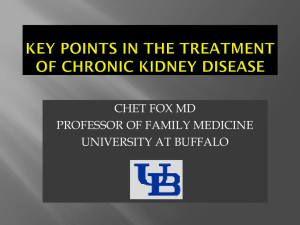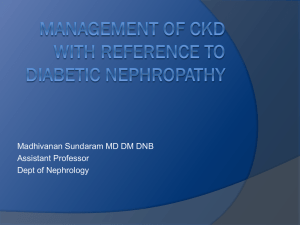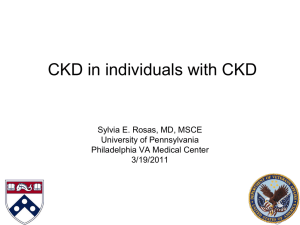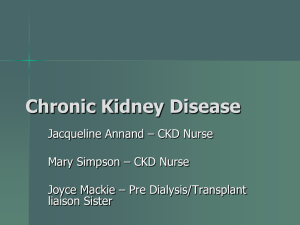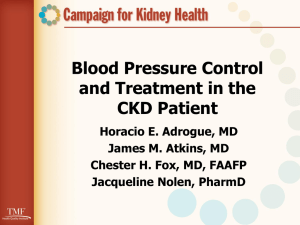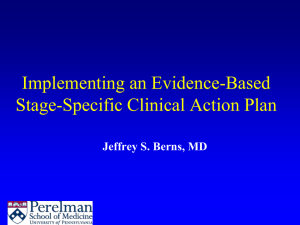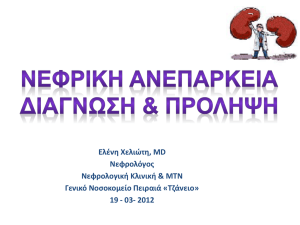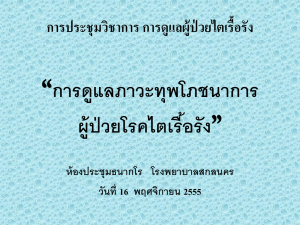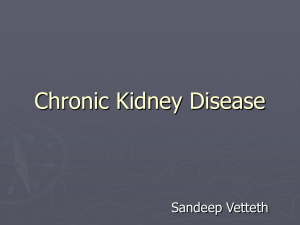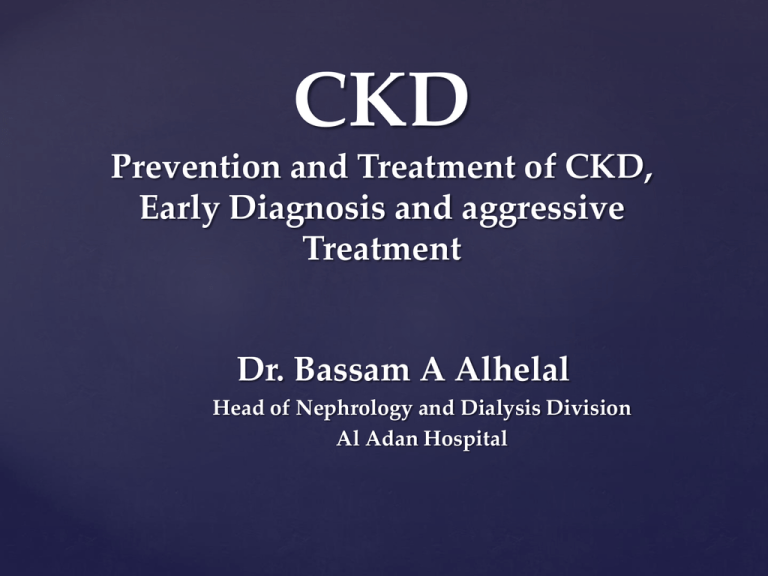
CKD
Prevention and Treatment of CKD,
Early Diagnosis and aggressive
Treatment
Dr. Bassam A Alhelal
Head of Nephrology and Dialysis Division
Al Adan Hospital
Objective
Definition of CKD
Epidemiology of CKD
Screening & Diagnosis
Prognosis and Progression
Complications of CKD
Prevention of CKD progression
Definition
Structure abnormality with or without low GFR
Imaging
Urinary abnormalities ( protein, blood)
Histological abnormalities
GFR less or equal 60 ml/min 1.73m2
Persistent for > 3 months
GFR Measurement
Measured GFR
Estimated GFR
Concerns of measured GFR
Inulin GFR is the Gold standard modality
Not used often in practice
Cost $$$$
Time consuming
Useful in limited clinical scenarios
Kidney donors with borderline GFR
GFR > 60
Older patients (more accurate)
Nephrotoxic drug dosing
Post Transplant CKD
Estimated GRF
Cockroft-Gault Formula
Modification of Diet in Renal Disease (MDRD)
CKD Epidemiology Collaboration Equation (CKD-EPI)
Cockroft-Gault equation
Age
Weight
Cr
MDRD equation
Age
Sex
Race
Cr
CKD-EPI equation
Age
Sex
Race
Cr
Comments
Cockroft-Gault
Estimate CrCL not GFR (overestimate GFR)
Not Accurate for GFR > 60
Issues with obese and elderly patients
MDRD
More accuracy and precision over CG equation
Validated for Af American, DM CKD and Tx Recipient
Not validated in Elderly, Pregnant women and Children
Underestimate GFR in patients with normal GFR (Type 1
DM and Kidney Donors)
CKD-EPI
More accurate than MDRD esp for GFR >60
Replaces MDRD as per KDIGO 2012 recommendation
Epidemiology
Common world wide disease
Incidence and prevalence increasing
Progressive
ESRD leads to
Increased cost on the health care system
52 Billion $ by 2030
2% of UK health service budget
Higher patient morbidity / mortality
lower quality of life despite the cost
Epidemiology of CKD
Earlier report showed
Over all prevalence of CKD 11%
9% males
12% females
Factors affect the true prevalence
Most of the studies are based on single GFR result
Micro-albuminuria can be associated with other disorders & can be transient
Elderly patients (Age related low GFR rather than CKD)
Error in the measurement of GFR with formulas like CG and MDRD
Prevalence of CKD
Study
NHANES III
PREVEND
NEOERICA
HUNT II
EPICNORFOLK
Country
USA
Design
Number
Micro Alb CKD
CS/L
15K
12%
Netherland CS/L
40K
7%
UK
Norway
UK
CS
130K
CS
65K
6%
CS
24K
12%
11%
17%
10%
MONICA
Germany
CS
2K
8%
AusDiab
Australia
CS
11K
6%
TAIWAN
Taiwan
CS/L
462K
12%
Beijing
China
CS
14K
13%
Takahat
Japan
CS
2K
14%
10%
Epidemiology of ESRD
About 1% of the prevalence of CKD
Improve patient survival on dialysis
Improve dialysis Therapy
Better management of CVS diseases
Improve management of ESRD
Anemia
CKD
Epidemiology of ESRD
Incidence
USA
Prevalence
360
1626
Caucasians
279
1194
African Am
1010
5004
Natives Am
489
2691
Hispanic
481
1991
Australia
115
aboriginal 441
789
2070
Japan
275
1956
UK
113
725
France
140
957
Germany
213
1114
Italy
133
1010
Spain
132
991
Data from Kuwait
Year
New
Patients
Transplantes
PD
Death
2011
94
13
6
18
2102
90
17
7
30
2013
96
15
4
28
Total
260
Kuwait 4 centers ESRD
prevalance
Population
ESRD
Mubarak
152500
203
Al-Adan
180500
274
Farwania
164083
117
Jahra
95000
193
MK
136127
---
Total = 728211
Total = 787
Rate of ESRD based on 2005 censes is 1 per 1000 or 1000 per million population
Diagnosis and Prognosis
Screening for CKD
Screening for the general population is not costeffective
NKF Recommend screening for all High risk
population
Measure BP
Measuring serum CR
Measuring Urine for ACR
Urine for RBC and WBC
ACP 2013 clinical practice guideline recommend not to
scren for albuminuria for patients already on ACEI or
ARB
International Recommendations for
Target population Screening for CKD
Target Group
KDOQI
UK NICE
CARI
CSN
Elderly
✔
HTN
✔
✔
✔
✔
DM
✔
✔
✔
✔
Atherosclerosis
✔
✔
✔
CVS and Heart Failure
✔
✔
Urological disease, Stone or UTI
✔
✔
Systemic Autoimmune disease
✔
✔
✔
Nephrotoxic drugs
✔
✔
✔
High risk ethnic groups
✔
Family history if CKD
✔
✔
✔
✔
Staging & Prognosis of CKD
New staging system is based on triad
GFR category
Albuminuria and ACR
Cause
Systemic or not
Staging and Classification
GFR
Albuminuria
Cause
Systemic
Not
Stage 3 further
divided to 1a & b
Measurment of Albuminuria
Albuminuria
ACR
A1
A2
A3
< 30mg
30-300mg
>300mg
< 3mg/mmol
3-30 mg/mmol
> 30mg/mmol
Natural History of CKD
Variable course of Progression
Disease related
Age
Ethnicity
Not all progress to ESRD
Many die from other causes esp CVS before reaching ESRD
Progression in descending order
DM (10 ml/min per year)
Chronic GN
HTN
Interstitial nephritis
Progression Factors
Non-modifiable
Modifiable
Age
Hypertension
Gender
Proteinuria
Race
Albuminuria, CKD & CVS
Genetics
RAAS
Loss of renal mass
Glycemic control
Obesity
Lipid
Smoking
Uric Acid
Risk Stratification & Prognosis
Detecting CKD Progression and
GFR monitoring
Progression of CKD
Drop of GFR > 25% from
baseline with drop in GFR
category
Sustained decline in GFR of
> 5 ml/min/1.73 m2/yr that is
Rapid progression
Slowing GFR progression
1. BP Target
Relaxed Target blood Pressure as compared with previous
recommendations.
Current recommendation
- Less than 140/90
-Less than 130/80 for those with proteinuria
ACEI or ARB should be the first line therapy
Lower BP (SBP < 120 and/or DBP < 70) should be avoided
- No proven benefit
- Increased CVS complication
2. CKD and AKI
All CKD pts are a increased risk of AKI
Heavy proteinuria, DM & HTN increase likelihood
AKI impacts progression conversely
Extra care is taken during:
Major surgery, intercurrent illness, exposure to nephrotoxins
3. Glycemic Control
Diabetes is the leading cause of CKD worldwide
25-40% of T1 & T2 DM develop DKD within 20-25ys of onset
Mortality of DM with high AER is twice that of normal AER
Aim for HbA1c of 7% to prevent or delay DKD
Avoid HbA1c < 7% in pts at risk of hypoglycemia
4. Protein Intake
High protein intake causes accumulation of uremic toxins
This may suppress appetite & cause muscle protein wasting
Poor protein intake may cause loss of LBM & malnutrition
Value of protein restriction in slowing GFR loss is unclear
Avoid high protein intake (>1.3g/kg/d) in progressive CKD
Effect of good BP & BS control & proteinuria reduction?
High intake of non-dairy animal protein must be avoided
Aim for protein intake of 0.8g/kg/d when GFR < 30 ml/min
Very low protein intake may not protect against GFR decline
5. Salt Intake
Lower salt intake to < 5 g/d
CKD pts have impaired sodium excretion
High sodium intake
That is < 2 g/d or < 90 mmol/d of sodium
Raises BP & proteinuria & induces glomerular hyperfiltration
Blunts the response to RAAS blockade
Salt restriction reduces albuminuria
Independent of effect of salt restriction on BP reduction
6. Uric Acid and CKD
Hyperuricemia (uric acid > 400) is common in CKD pts
Growing body of evidence implicate hyperuricemia in:
Treatment of asymptomatic hyperuricemia may:
CKD progression
adverse CV outcome in CKD
Delay progression of CKD
Improve LV mass & endothelial function
However, evidence are inadequate to support the
recommendation of treating asymptomatic hyperuricimia
7. Metabolic Acidosis
Prevalence of acidosis in CKD:
GFR < 90 – 8.5%
GFR < 60 – 9.5%
GFR < 45 – 18%
GFR < 30 – 30%
Chronic metabolic acidosis is associated with:
Increased protein catabolism & muscle wasting
Uremic bone disease
Impaired glucose homeostasis
Impaired cardiac function
CKD progression & increased mortality
Cont,
metabolic acidosis
CKD pts with HCO3 < 22 should be given oral HCO3
Reverses harmful effects of acidosis
Did not affect BP control or hospitalization for heart failure
These effects are seen with NaCl & not NaHCO3
9. Life style modification
Exercise 30 min 5 days a week
Keep BMI 20-25
Stop smoking
Timing of Referral to
Nephrologist
Refer to nephrology in the following circumstances:
AKI or abrupt sustained fall in GFR
GFR < 30 ml/min/1.73 m2
Albuminuria > 300 mg/d or proteinuria > 500 mg/d
Progression of CKD
Drop of GFR > 25% from baseline with drop in GFR category
Sustained decline in GFR of > 5 ml/min/1.73 m2/yr
Cont,
referral to nephrologist
RBC casts or unexplained hematuria
CKD & HTN resistant to ≥ 4 antihypertensive
agents
Hereditary kidney disease
Persistent K abnormalities
Recurrent or extensive nephrolithiasis

![Risk Adjustment Factor [RAF]](http://s2.studylib.net/store/data/005748329_1-97f04b2983127ae4930cafa389444167-300x300.png)
